
HarvesTimes The journal for agricultural professionals 05.24 CLAAS NEWS | PRODUCT NEWS | CUSTOMER STORIES
CLAAS tractors with Connect package
Access to all machine data at all times
Precise and efficient with CEMIS 1200 terminal
Automatic Documentation and online Task Management








The ARION 600 CMATIC o ers:
Seamless acceleration and deceleration between 0-50kph.
Uninterrupted power for maximum productivity and fuel e ciency.
3 simple drive modes.
Auto stretch brake.
Tractor implement control.
Engine droop adjustment.
Contact your local CLAAS dealer today or go to o er.claas.com














The easiest way to keep on track.

763100
cuk.reception@CLAAS.com or visit claas.co.uk facebook.com/CLAAS.UnitedKingdom








HarvesTimes 3 Contact
Email:
Cover photo: High Horsepower event at Saxham, see page 7. Contents CLAAS and Dealer News Welcome to the Innovation Lab at Agritechnica 2024 4 Multiple awards for CLAAS products 6 High Horsepower event at Saxham 7 CLAAS UK welcomes RABI ...................................................... 7 New standard for cab assembly ............................................... 8 Record financial year 8 Dealer awards 9 Special delivery 10 Celebratory milestones 10 Rising Stars: CLAAS UK Work Exchange programme 11 The appeal of earning while you learn 12 Better Connected with CLAAS UK www.instagram.com/claas_uk http://bit.ly/CUK_youtube www.facebook.com/CLAAS.UnitedKingdom claas.co.uk Product News and Customer Opinion Digital Products New CLAAS Connect digital ecosystem 14 Testimonial LEXION & TELEMATICS, Ian Matts, Northamptonshire 16 Green Harvest 50 years of JAGUAR self-propelled foragers 18 Testimonial JAGUAR 970, McConaghy Contracts, County Antrim ............ 20 Section Control for LINER swathers 22 Testimonial DISCO, LINER, VOLTO, W J Hobbs & Sons, Cornwall 24 Telehandlers SCORPION on track at Le Mans 26 Tractors New FL C front loaders for AXOS and ARION 28 AXION TERRA TRAC as a key machine for spring fertilization 30 Testimonials ARION 460, Rory Young, Dumfriesshire 32 ARION 410, ARION 630 and AXION 810, James Marshall, Midlothian 34 ARION 650 CEBIS, Mike Davey, Cornwall 36 AXION 800, ARION 650/640/630, Craig and Claire Grant, Aberdeenshire 38 AXION 870 CMATIC, P A Lakey & Son, Lincolnshire 40 XERION 5000 VC, Rupert Arneil, Gloucestershire 42
us on: 01284
Welcome to the Innovation Lab at Agritechnica 2024

In addition to a host of new and current products, CLAAS dedicated a central part of their stand at Agritechnica to what it called the Innovation Lab. Here visitors could get a behind-the-scenes glimpse of what the future holds thanks to development projects in the fields of cab/ HMI, autonomy and alternative drives, some of which are market ready while others are more long term.

AUTONOMOUS XERION
High-level automation and autonomy are key globally relevant themes for numerous agricultural applications and the most eyecatching development was an autonomous XERION 12 Series tractor, equipped with relevant sensors such as LIDAR and camera systems, as well as other technology for track planning and process monitoring. Other vehicles are already undergoing further research and component testing in the field.
“Large tractors equipped for highly automated and autonomous work are mainly of interest to farms that cannot make full use of a conventional AgBot or whose machine and implement fleet does not match the AgBot’s performance characteristics”, explains Christoph Molitor, Head of Technology Management at CLAAS.
The autonomous XERION 12.590TT is technically set up for both high automation (Autonomy connect Co-Pilot) and autonomy (Autonomy connect Auto-Pilot). Co-Pilot provides the highest level of process automation, with the operator mainly performing a supervisory role, while preplanned tractor and implement functions and settings are performed fully automatically by the tractor-implement combination.
With Auto-Pilot, the tractor operates fully autonomously with no one in the cab. Tasks are planned exactly as with Co-Pilot, but
4 CLAAS NEWS
the tractor is equipped with enhanced environment recognition technology in addition to LIDAR, including special camera systems, further safety technology and automated braking.

BATTERY-ELECTRIC SCORPION 732E
Also on display was a battery-electric version of the SCORPION 732. Battery-electric, locally emission-free drives offer significant potential in the lower performance range and for applications such as materials handling, yard work and municipal use.
A battery-electric telehandler like the CLAAS SCORPION 732e – a joint development with Liebherr – offers many advantages: the machine is very quiet and locally emission-free, which is particularly beneficial for people and livestock when working in buildings. Two independent 90 kW electric drives, a modular 64 kWh battery concept for up to 4 hours’ use and a 22 kW onboard battery charger ensure ample performance and flexibility. It offers maximum tractive power of 53 kN and a top speed of 30 km/h.
THE CAB OF THE FUTURE
What about the cabs of the future? With greater automation, there will be periods when operators have so little to do – even in terms of supervision – that they will feel underworked and tire quickly. So in future, harvesting machine cabs might enable operators to perform other activities, such as office work, in addition to those relating specifically to the machine.
One project, ‘Cab 4.0 – OnField’ uses technology such as joystick steering, operator fitness detection and eye tracking to show what the future workplace might look like. Using different human-machine interfaces such as cameras, head-up displays, monitors and keypads, it is possible to continuously monitor the operator’s occupation level and when operators are underworked, the system suggests alternative tasks and activities for them to do.
In another project, CAB10Future, machines could be fitted with a more comfortable workspace with a seat that rotates by up to 60 degrees in both directions for close-up work; intelligent lighting for a more relaxed working environment; large screens in the front focus area for full-on digitisation; and sustainable construction with easily replaceable wear-prone modules and use of recycled materials. ‘Transparent’ A-pillars with cameras and displays reflecting the environment and the absence of a steering column (autonomous operation) create an impressive spatial experience for the operator.
CLAAS NEWS
SEMI-ELECTRIC COMBINE HARVESTER
Combine harvesters often face a mix of operating conditions during harvesting. Changes in the crop, terrain or harvesting conditions mean that drives and power units are constantly having to adjust to achieve the best possible overall performance.
Avoiding major speed fluctuations and variable crop flow not only increases efficiency, but aids separation and cleaning performance.
To help achieve this, CLAAS has developed a semi-electric drive on the combine harvester that helps flatten load peaks and significantly increase efficiency. When harvesting conditions are straightforward, engine power not needed for the combine harvester drive is converted to electrical energy via a generator and stored in the battery. When harvesting conditions become difficult, for instance in high-yield areas or when discharging on the move, the electric motor steps in to support the mechanical drive using stored electrical energy from the battery, replacing a conventional engine ‘boost’. This enables load peaks to be bridged for several seconds, and with automatic load distribution, the combine harvester can consistently operate in the optimum performance range.
This development also means that the combine can be fitted with a smaller, less powerful engine operating at 1600 instead of 1800 rpm thanks to the additional 40 kW electric motor and 3 kWh battery with 48 V inverter. In field trials, this semi-electric hybrid concept reduced fuel consumption by up to 10 per cent.


HarvesTimes 5
Multiple awards for CLAAS products

The design, innovation, technical prowess and market impact of the latest CLAAS products have been recognised by a number of awards juries, both in Europe and the USA.
The big winner has been the XERION 12 Series, which has swept the board when it comes to awards, winning four major awards in as many months. But other new products, such as CEMOS for tractors, 3A – ADVANCED AUTOMATION & AUTONOMY, TRION and VARIANT baler have also received recognition.
MULTI AWARD WINNING XERION 12.650TT
First up was the announcement at Agritechnica that the international Tractor of the Year jury had made the XERION 12.650 TERRA TRAC its Tractor of the Year in the main category of the renowned award, beating three other competitors.
A couple of days later, the XERION 12 Series went on to receive its second award at the show when it received the Farm Machine 2024 award in the Large Tractor category.
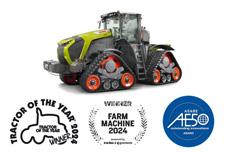
“We are overwhelmed that after 25 years of XERION on the market, Helmut Claas’ vision has also received this prestigious award,” explained Dr. Martin von Hoyningen-Huene, Chief Technology Officer CLAAS Group and responsible for the Tractors and Implements division.
In December it was announced that the XERION 12 Series was one of seven CLAAS products to be awarded an AE50 Award from the American Society of Agricultural and Biological Engineering (ASABE). The presentation of the award was made at the ASABE Agricultural Engineering Technology Conference at Louisville, Kentucky in February.
The quadruple was reached in January when the XERION 12 Series was awarded the Grand Prix in the International Product Development category at the AGGROmeshEXPO in Budapest, Hungary.
AGRITECHNICA AWARDS
Ahead of the Agritechnica show in November, it was announced that CLAAS had won two silver awards.
The first was for a new multi-dimensional linkage control system that is currently in development as part of CEMOS for tractors that integrates the hydraulic top-link and implement into the linkage control system.
The second Silver medal was awarded to the 3A – ADVANCED AUTOMATION & AUTONOMY consortium for its open approach to advancing and developing highly automated and autonomous tractor-implement combinations for field cultivation. 3A then went on to win a second award at the show when it received a Machine of the Year 2024 award in the Smart Farming & Robotics category.
SEVEN CLAAS PRODUCTS RECEIVE AE50 AWARDS
Each year the American Society of Agricultural and Biological Engineers (ASABE) recognise the 50 most innovative new products and product innovations in North America, which have a significant impact on agricultural, food and biological systems.
This year, seven of those awards have been made to CLAAS product innovations.
In addition to the XERION 12 Series, also recognised were the CEMOS for tractors driver assistance and process optimisation system and the TRION 740 combine. Two awards were made for innovations on the new VARIANT baler. The first was for the new net wrap system on the baler and the second for the SMART DENSITY system. There were also two awards for DISCO mower innovations. On the DISCO 360FRC, the new innovative drive system for the roller conditioner was recognised, as was the new side-shift technology, innovative driveline and the merger belt design on the new DISCO 9700RC AUTO SWATHER.

6 CLAAS NEWS
Seven CLAAS products received AE50 awards from the American Society of Agricultural and Biological Engineering at their awards ceremony in February
The team from CLAAS importer Axial celebrate after the XERION 12 Series was awarded the Grand Prix in the International Product Development category at the AGGROmeshEXPO in Budapest, Hungary
High Horsepower event at Saxham
CLAAS UK recently organized a unique high horsepower tractor event for tractor drivers and owners. Spanning a week the event provided in-depth discussion and presentations on the full CLAAS range of high horsepower tractors (205hp+) , backed up by practical in field demonstrations of both the AXION 960 and the AXION 960TT on a nearby farm.
Customers were able to view the performance of the tractors in the field – travelling alongside the machines in a shooting trailer, providing each group with maximum visibility.

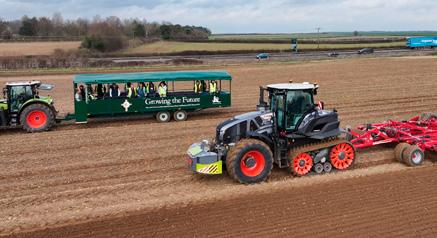
CLAAS UK Welcomes RABI
CLAAS recently welcomed the RABI to its headquarters.
Established in 1860, this award-winning national charity has been offering financial, practical and emotional assistance to the farming community across England and Wales for generations.
A fund raising day at CLAAS UK aimed to raise greater awareness of the charity’s work, bringing together like-minded people from all walks of the farming sector to network with fellow supporters/ friends/acquaintances and businesses.

The 60 attendees had the full ‘CLAAS experience’ including a short presentation, a tour of the site facilities and the opportunity for a small group to drive tractors on the all weather test track, at the dedicated Customer Experience Centre – CXC.
With the assistance of their local sponsors on the day Ashton Legals, Carter Jonas, Wilson Wraight and Ensors, RABI raised over £3,000 for the charity.

If you require further information, support or advice from RABI please call their helpline on freephone 0800 188 4444.
HarvesTimes 7 CLAAS NEWS
A new cab assembly production area has been completed at the CLAAS Tractor factory in Le Mans. This follows on from the 40 million Euro ‘Future Factory’ project completed in 2021, that saw the complete replacement of the main assembly line with a state-of-the-art production system incorporating automated guided vehicles (AGV) to transport tractors between assembly stations.
The new cab assembly area, which also uses AGVs, has been created to meet the envisaged expansion of product variety, from 2,800 to 4,000 part numbers in stock, and the need to also meet the increase in overall daily production capacities from 50 to 65 tractors a day.
The development also includes new, higher performance test benches that will be able to accommodate future cab models, and enable higher levels of quality assurance to be achieved.
New standard for cab assembly Record financial year
A substantial increase in sales saw the CLAAS Group record a 25% increase in sales to €6.1 billion, with the income before taxes tripling to €522.3 million.
“The 2023 financial year was very successful,” says CLAAS CEO Jan-Hendrik Mohr. “The substantial leap in sales in the past year reflects the high demand for agricultural equipment. Once the supply chain situation eased following the pandemic, we were able to systematically tackle the very high order backlog and deliver our agricultural machinery to our customers around the world, thanks to strong teamwork.”
“Sales again improved significantly in North America, and especially in Europe,” says CFO Henner Böttcher. “The successful issuance of €350 million in debt certificates and the increase of the syndicated loan to €850 million with simultaneous extension of duration also


allowed us to significantly strengthen our financial flexibility,” he adds.
CHALLENGING MARKET ENVIRONMENT
However, Jan-Hendrick Mohr warns that CLAAS is preparing for a more difficult market environment in 2024. “While the order backlog is returning to normal, the pace of economic activity is slowing perceptibly in our core markets in Central and Western Europe and North America, due in no small part to high inflation and mounting geopolitical tensions. In light of current events, the CLAAS Group will consistently pursue the strategy it has adopted and continue to build on its strengths.” The Group will focus on the development of new products and technologies. Technological solutions that have so far been viewed in isolation are to be even more strongly connected to each other going forward and made available to customers.
8 CLAAS NEWS
In € million 2023 2022 % change Net sales 6,144.5 4,925.5 +24.7 R & D Costs 302.4 279.1 +8.3 Income before taxes 522.3 166.3 +214.1 Net income 347.1 88.1 +294 Free cash flow 84.6 22.2 +281.1 Capital expenditure 207.7 200.6 +3.5 Total employees 12,131 12,116 +0.1
GORDONS named ‘Dealer of the Year’ With ‘Dealer Excellence’ awarded to RICKERBY
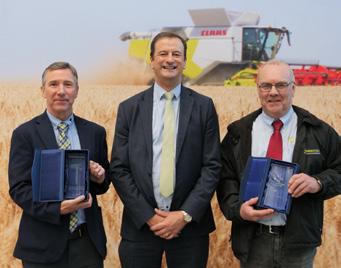
It was a clean sweep for two family owned CLAAS UK dealers in the north of England and Scotland in this year’s CLAAS Dealer Awards, with GORDONS being awarded the overall prestigious ‘Dealer of the Year’ award for 2023, while the ‘Dealer Excellence Award – Gold’ for 2023 was awarded to RICKERBY.
The CLAAS UK ‘Dealer of the Year’ award recognises the high overall level of performance by a CLAAS dealer in the UK and Ireland in three key areas: Finance, Dealer Performance and Customer Feedback.
The award is a major achievement for GORDONS, who were established in 1865 and are based at Castle Douglas in Dumfries & Galloway, with five branches covering the South West of Scotland. The award assesses not only the dealership’s overall performance, but the performance of each of its individual branches. The award also reflects the results of the annual Customer Feedback Survey and GORDONS scored very well in this category, underlining their commitment to their customer base and the first class customer care service they provide.
The ‘Dealer Excellence Award – Gold’ recognises the high level of service and support that RICKERBY offer their customers, and is another great achievement for CLAAS UK’s largest dealer. With nine branches, RICKERBY serve an area from Lancashire and Northumberland up to the Firth of Forth in Scotland.

HarvesTimes 9
DEALER NEWS For outstanding wear and corrosion resistance. Remanufactured genuine CLAAS Parts So your CLAAS remains an ORIGINAL So your CLAAS remains an original CLAAS. Find out more about CLAAS Parts claas.co.uk
Neil Montgomery of GORDONS (right) and Ken Conley of RICKERBY (left) were presented with their Dealer Awards by Trevor Tyrrell, Senior Vice-President (Western Europe & Oceania) and CLAAS UK CEO.
Special delivery
We were delighted to invite Mr James Puxley of Welford Estate and his combine operator Mr David Janaway to Germany in late February to see James’ new combine come off the production line at Harsewinkel. After a full tour of the factory, the combine was placed in the Atrium of the CLAAS headquarters and James and David were both presented with a ‘golden key’ to the new LEXION 8600TT.
The combine has since landed in the UK with James’ local dealer CLAAS WESTERN, in preparation for the 2024 harvest.

Celebratory milestones

Two of CLAAS UK’s longest serving independent family-owned dealers are this year celebrating major milestones in their association with the company.
Covering the north of England and parts of the Borders, 2024 marks the 70th year since RICKERBY took on the CLAAS franchise. In the West Midlands and the Welsh Borders it is also 60 years since MORRIS CORFIELD started selling CLAAS machinery.


Established in 1880 and based in Carlisle, RICKERBY today has nine branches that cover Lancashire, the north of England and the Borders of Scotland. Central to that growth has been the company’s association with CLAAS, having taken on the franchise in 1954. Their ‘Platinum Anniversary’ was the central theme of this year’s RICKERBY show in March, attended by over 3,500 customers. Centre stage was taken by the unique platinum coloured 70 years special edition ARION tractor. Also on display in recognition of the 50 years of the CLAAS JAGUAR was their new demonstration JAGUAR 970 for this season, sporting a Carlisle United film wrap!
Based at Broseley in Shropshire, MORRIS CORFIELD was established in 1959 and took on the CLAAS franchise five years later in 1964. Today its four branches serve an area from Cheshire down to Herefordshire and as of this year through into mid-Wales. While the company has enjoyed great success with the complete range of CLAAS machinery, from day one it’s in the combine market that the dealership has truly excelled, selling its first CLAAS SUPER 500 trailed combine to a farmer in Much Wenlock.
Congratulations to both businesses and we look forward to many successful years in the future!
10 DEALER NEWS
RISING STARS
CLAAS UK Work Exchange programme “The most fantastic experience”
In the last issue of HarvesTimes we featured Olivia HeskethParts Assistant at the Carnforth branch of RICKERBY. Olivia is the first Parts employee to take advantage of the UK Work Exchange programme and swap a wet winter in Lancashire for the sun and heat of Western Australia for three months.
Now back from her travels, we caught up with Olivia to hear about her experiences.
Olivia was working for Landpower at their CLAAS Harvest Centre in Esperance, which is in the south west of the country and their largest branch in Australia. The region is mainly arable, predominantly wheat, barley and oilseed rape, and the dealership will typically sell 20 new LEXION and five XERION a year, along with a lot of CLAAS and other new and used machinery.
“The whole working atmosphere is different. In the UK, farmers want to get on due to the weather and forever changing environments, so they want to make the most of the hours available as they never know what the following day will bring.
“In Australia everything is so much bigger in terms of the land and how far away the farms are. One of the nearest farms was 43 miles away. The weather is more settled and everyone is far more laid back and chilled, so I did find it very difficult to redirect my ‘get on’ nature and had to channel that into other aspects of my job.
“The experience and the life skills this exchange has set me up with have been invaluable. The team at Esperance gave me the utmost support and they really welcomed my outlook and motivation to help them implement change.
“Change is always hard, but the team there really welcomed my thoughts and ideas. It was fantastic to have the feeling at the end of my exchange knowing, feeling and being able to witness that I had made a difference in comparison to when I arrived. The thanks I got from everyone was overwhelming and very much appreciated.
“Personally, the exchange has given me a lot more confidence to have faith and belief in myself to be able to work on my own in diverse situations. With harvest, it was very much sink or swim, and you quickly learn to adapt to all ways of working. It gave me a flourishing self-belief, knowing I have the capabilities to back myself and work things out for myself without relying on others.
“Professionally, working with people in different roles, that I wouldn’t normally work with was a great adaptation to learn.

The customers were really understanding on the ‘phone and this built my confidence massively when working by myself, and gave me the ability to overcome situations that in the past would have been a big thing for me. It has helped me 10-fold having had this experience and has set me up to be in a far better position in my job at RICKERBY.
“I would wholeheartedly 100% recommend this to anyone thinking of doing the exchange. CLAAS Landpower are always looking for exchange people to work in Australia or New Zealand, especially during harvest. They were so welcoming and happy to see me arrive, so that I could help out as soon as I arrived there and will welcome anyone who is interested. It was the most fantastic experience and many thanks to CLAAS, RICKERBY and Landpower.”

HarvesTimes 11 DEALER NEWS
Landpower’s CLAAS Harvest Centre at Esperance, Western Australia with 35 new and customer’s LEXION combines ready for PDI or pre-harvest checks.
Olivia at work in the Parts Department.
The appeal of earning while you RISING
With 8 Land-Based Service Engineering apprentices currently within the CLAAS WESTERN dealership, 3 – Josh Martin, Ben Matthews and Connor Babb – are based at the company’s main Cirencester branch.
All are at different stages of their training. Josh is currently doing a one-year parts apprenticeship before starting his Level 3 Apprenticeship Standard in Land-Based Service Engineering Technician course in October. Ben is currently in his second year and Connor his final fourth year and will graduate this autumn.
While Ben and Connor have helped out on farms in the past, Josh comments that coming from Swindon his only experience in agricultural machinery had been playing on Farming Simulator. But common to all of them is an interest in machinery and the opportunity to develop a wide range of personal and professional skills whilst training on the job and earning a wage. The skill set they will aquire during their Apprenticeship will stand them in great stead for their future careers.
“I never wanted an office job,” comments Josh. “I have always been hands on and enjoy taking something that’s broken and making it work again. My father is involved in the Swindon to Cricklade heritage railway and has a couple of diesel locomotives as well as old motorbikes, so I have always been around machinery. I would see a tractor working in a field and it really appealed to find out more about agricultural machinery. In Year 10 I got the opportunity to do work experience at Western Cirencester, following which I applied to join the Apprenticeship. There were no spaces available at Cirencester last autumn, but they offered me the opportunity
to do a one year Parts apprenticeship, which has been great and given me a better understanding of that side of the business and quite how many parts there are in a combine or tractor.”
As with Josh, having done some work experience at CLAAS WESTERN, Ben decided he would prefer to take on an Apprenticeship, earning while he learnt, rather than go to college at Lackham. Connor started his training at Sparsholt College, but with the outbreak of Covid this got interrupted and rather than learn from home, he opted to leave and took up the initial opportunity to do work experience at Cirencester before being one of the last to join the Reaseheath based CLAAS Apprenticeship in August 2020.
“The attraction for me is that it is a lot better than college,” says Josh. “There is a really good team here, and I like that I am given responsibility from the start, but that if I need help there is someone there to support me. My friends look at me and see what I am doing and think it’s really cool.”
FAMILY SPIRIT
The team and ‘CLAAS Family’ spirit is also something that Connor has noticed and appreciated. “The support and camaraderie you get from throughout CLAAS, whether it is within the dealership group, other dealerships or from Saxham is amazing. Everybody is supportive and helpful and it was often commented at Reaseheath how the CLAAS apprentices always stood out and had pride in who they worked for. It was also noticeable that we were given far more responsibility and the opportunity to have a van and work on farm by our dealerships far sooner than apprentices with other companies.”

12 DEALER NEWS
Josh Martin
learn STARS

Even as a second year apprentice, Ben enjoys the responsibility he is given and the trust shown in him to go out on farm and work by himself. “It’s nice to have the independence and to start thinking for yourself rather than hide behind someone else, but knowing that there is the backup support there if you need it.”
One of the main reasons for CLAAS UK deciding to take apprentice training ‘in-house’, establish its own Apprentice Academy at Saxham and ‘grow their own’, was to ensure that these future service engineers gained the high level of technical skills and product knowledge required by their dealerships and customers, along with appreciation of the culture of CLAAS and its ethos.
THE LATEST MACHINERY
“Reaseheath was very good as far as it went and the teaching staff were very passionate in what they did,” says Connor. “But the machinery in the training school was not up-to-date, for instance they didn’t have a combine there, plus you were training alongside apprentices from both independent dealers and other manufacturers, so often you were working on a rig or being taught something that was not applicable to what I would be doing and it got a bit repetitive.”
By comparison, Ben has found that topics that he has learnt in the classroom at Saxham are then put into practice on real ‘live’ operational machinery. “In my last block we were training on hire tractors that had just come back in. The set-up at Saxham is

fantastic and we have access to all the latest machinery, so I am gaining far more specific knowledge and far wider training than I would have got at college. I also enjoy learning about all the basic fabrication and welding skills; it’s all done for a purpose.”
While Ben enjoys the mechanical aspects of his apprenticeship, for Connor it is the diagnostics element that interests him most, in addition to the more detailed training courses he is now doing in his final year.
“I enjoy the challenge of fault finding. Not being mechanical you can’t visualise it, so it is far more rewarding when you do get to the cause of a problem. I do a lot with tractors and combines, and this year I have been doing courses looking at CLAAS Power Systems more closely, along with advanced electronics and hydraulics, a course on MTU engines as well as other product courses with Horsch.
“One of the most interesting however was the Customer Excellence course in which we learnt about the psychology of why people react in the way that they do, how to handle customer situations and to remain professional. I do love going out onto farm and often you are under a lot of pressure because of a breakdown, but the satisfaction is in coming away, knowing they are relying on you to get them going again and that you have done a good job.”
HarvesTimes 13 DEALER NEWS
Ben Matthews Connor Babb
New CLAAS Connect digital ecosystem

CLAAS has brought together machine management, service planning and licence management with yield mapping, application maps and documentation on a single, cloudbased platform – the new CLAAS connect. The ‘Next step in farming’ focusses on even greater connectivity and user-friendliness and a closer relationship between customer, dealer, manufacturer and partners based on more effective communication.
SEAMLESS CONNECTIVITY ON ONE PLATFORM
From purchasing advice to purchase agreement and delivery of machine; digital operating instructions, lubricant adviser and connection to the CLAAS Parts Shop to precision farming; fleet optimisation with tools such as CEMOS Adviser to documentation, licence management and maintenance planning: the new CLAAS connect with Machine connect, Farm connect, Field connect and Fleet connect licences seamlessly connects all digital solutions in the CLAAS product world, simplifies and speeds up many planning and documentation tasks and strengthens the bond between farmer, dealer and manufacturer.
While sharing many proven elements and functions of the current generation CLAAS connect, the new, enhanced version
features new tools and additional functions. Machine connect (TELEMATICS) now supplied as standard already ensures seamless digital connection between platform and machine.
All digital solutions will be gradually combined in a single, cloudbased platform with the emphasis on simplicity and ease of use:
• All information on one platform with one CLAAS ID: multimanufacturer machine and fleet management, licence management, documentation and precision farming applications combined under one roof – with a standardised user interface.
• Seamless connectivity in all areas of digital machine management, from the quotation and purchase process to machine data management and service planning, lubricant adviser, spare parts ordering and other supporting service functions such as digital operator’s manuals.
• Complete overview of all licences for the first time: correction signals for automated steering by GPS PILOT, telemetry, ISOBUS activations and much more.
• Broad integration of agronomic functions such as yield mapping, task management, potential and application maps, and documentation.
• Access to all current data, anytime, anywhere – on smart phone, tablet and PC.
“The focus was to develop a common platform linking all relevant portals, shops and functions with a simple, user-friendly interface that is very easy to navigate, and one ID to access all areas and
14
PRODUCT NEWS
ecosystem
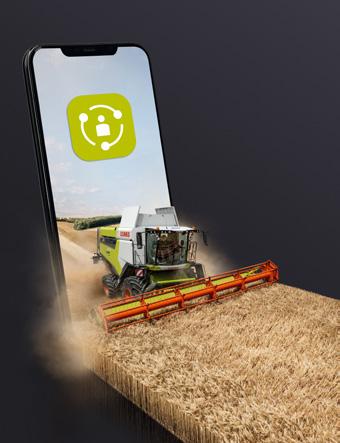
information,” explains Wolf-Christian von Wendorff, Senior Vice President Digital Business. “The new CLAAS connect delivers on these requirements, while at the same time retaining the wellestablished and well-used functions of the existing digital platform.”
MACHINE AND CLOUD PLATFORM IN ONE ECOSYSTEM
Rather than treating machine and digital fleet management as separate entities, the new CLAAS connect for the first time considers them as a whole. Starting with advice and a quotation for a new CLAAS machine: if the customer is already registered with CLAAS connect, they can access the CLAAS configurator directly via their CLAAS ID, configure their desired machine and request a quotation or demonstration. The appropriate dealership then prepares the quotation or provides a demonstration machine. If the customer makes a purchase, the machine data is uploaded to the customer’s CLAAS connect portal on delivery. This gives the customer direct access to the digital operator’s manual for their machine. They can also find out which lubricants their machine needs, as this information is automatically provided as well.
With the 5-year Machine connect licence supplied with the machine, the relevant maintenance intervals are automatically entered in the portal – giving farmers and contractors a clear
overview of upcoming maintenance work and enabling CLAAS dealerships to plan schedules and capacities in advance.
Machine performance data can be prepared, analysed and documented in CLAAS connect – just as before in TELEMATICS. With a Fleet connect licence, third-party machines in mixed fleets can easily be connected to CLAAS connect via the DataConnect interface, enabling data such as location, machine status or current fuel and AdBlue levels to be displayed there. In addition, machine data can be transferred to partner companies via the point data interface.
CEMOS Advisor, the platform extension of CEMOS – the leading assistance and process optimisation system for numerous CLAAS tractors, combine harvesters and forage harvesters – is an integral component. Performance data and settings for all CLAAS machines stored on the platform can be viewed and compared with one another, enabling adjustments to be made to maximise the performance of the overall fleet.
Furthermore, with licence management, customers can get a complete overview of licence coverage and runtime at any time.
PRECISION FARMING AND DOCUMENTATION
The add-on licences for Farm connect with Field connect and Fleet connect provides farmers and contractors with numerous options for precision farming applications. In Field connect farmers can access functions needed to prepare potential and application maps from geodata such as satellite images or soil analyses. Field boundaries and other master data can be easily imported as SHAPE or ISO-XML files. Yield maps from different machines and manufacturers can also be incorporated with ease.
Fleet connect automatically documents field-specific task data relating to yield, constituents or application rate, enabling the status and progress of preplanned tasks to be tracked virtually in real-time on smartphone, tablet or PC. It is also possible to create reference lines and plan tracks based on field boundaries in Fleet connect – alternatively, this can be done on the machine’s CEMIS 1200 terminal, if it has one.
Other compatible farm management information systems can be connected to CLAAS connect via Connection Manager. Furthermore, with CLAAS connect it will be possible to exchange data between different CLAAS IDs using Data Sharing in future. This will simplify task planning, implementation and documentation, including invoicing for farmers and contractors.

HarvesTimes 15 PRODUCT NEWS
Find out more about CLAAS CONNECT.
Ian Matts, Brixworth Farming near Northampton
Always performing efficiently
Brixworth Farming was one of the first UK businesses to invest in TELEMATICS on its combines some 15 years ago, predominantly as an early diagnostic aid for any arising problems.
“We bought into TELEMATICS because we could see the potential for reducing downtime. At the time our two LEXION 580s were expected to clear over 2500 ha and so we were really pushing the envelope in terms of their capacity.
“My father – Charles – could see how the system could improve harvest efficiency and the potential in yield mapping for future inputs’ management.”
“Today we’re in quite a different position and are looking at ways of reducing our cropped acreage to put aside land for environmental stewardship. In the last three years our shareholders have pulled a total of 450 ha out of arable
production and TELEMATICS has proved a really useful tool in identifying which areas to set aside.
“Field size is the single biggest factor influencing the efficiency of our operations, and headlands account for over 50% of our farmed area, so initially it was the smaller fields that were put into stewardship.
“TELEMATICS is now an essential tool in our long-term decision making. With 15 years of yield data we now have a true picture of what different areas are capable of. Today I have all our fields ranked by yield potential and know where to target our inputs.”
HARVEST EFFICIENCY
“On a day-to-day basis throughout harvest I use TELEMATICS to monitor our overall progress and daily outputs. That way I can make judgments on things like chaser bin logistics or whether we’re going to need to call in a third combine if we’re not getting on as well as we should.
“TELEMATICS means we can keep a real-time tab on combine
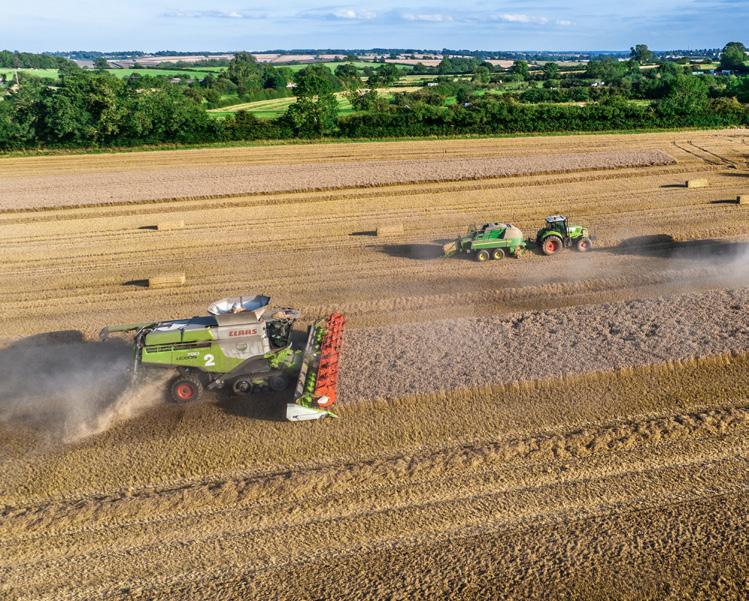
16
LEXION &
efficiently
waiting times and decide whether we need to put on extra trailers or lorries. One year I worked out we had a total of 24 hours waiting for lorries and off the back of that we totally reorganised our harvest logistics, moving to dedicated hauliers committed to not letting us down.
“But it’s other seemingly less significant things that TELEMATICS has helped us to identify, like the direction in which the combines unload. Having the chaser bins taking a load as they travel back towards the gateway can have a huge impact on how quickly they get unloaded and get back to the combines. It’s all about the aggregation of marginal gains – lots of small things add up to make big improvements in efficiency.”
FUEL USE
“One of the key features TELEMATICS provides us with is an accurate picture of fuel use. This is particularly important where we’re working on a stubble-to-stubble contracting basis because it gives a true indication of how much diesel we’re burning for every hectare of crop cut.”

WHY CLAAS?
“When we were previously cutting over 2,500 ha each season we needed the highest capacity machines available and CLAAS’ flagship LEXION always exceeded anything else when it came to raw output.
“But it isn’t all about putting hundreds of tonnes in the shed every day – we aim to get a premium on every crop and so the quality of sample is really important to us. Equipped with CEMOS Auto and grain quality cameras, LEXION seem to consistently produce a much cleaner sample than anything else, without impacting on daily throughputs.
“They’re also reliable machines – in the last six harvests with our two 780s we haven’t had any significant downtime. But even if we did have we have the peace of mind knowing that our dealer – MANNS – has stand-by combines in the yard.
“To help in that respect we also opt for the full MAXICARE service package which provides us with true fixed running costs so we can accurately budget for the lifetime of that machine.”
TELEMATICS is now an essential tool in our longterm decision making.
Ian Matts

HarvesTimes 17
TELEMATICS
Ian Matts
PRODUCT NEWS
50 years of JAGUAR self-propelled

It is 50 years since CLAAS first launched the JAGUAR 60 SF in 1973, during which time, thanks to its many innovations and durable, efficient technology, JAGUAR has become the byword for efficient, cost effective, high output forage harvesting and world market leadership with over 45,000 units manufactured.
Like a tractor and a combine harvester, the self-propelled forage harvester is today a key machine for many farmers and contractors. It guarantees ideal chop length and kernel processing as well as top performance and versatility – whether its harvesting forage or biomass, elephant grass or sugar cane straw in Thailand and lavender in the South of France.
“For 50 years, the JAGUAR has stood for innovation, efficiency, productivity and reliability and is surely second to none in terms of the mark it has made on the forage harvester segment throughout these five decades”, says Dominik Grothe, Senior Vice President Self-Propelled Harvesters. “But CLAAS does not just owe its position as world market leader to technological advances and, by extension, to the developers and the feedback from our customers. Much of the credit must also go to our distributors and service partners because the forage harvester is a key machine, especially for contractors, and short downtime aided not only by reliable technology but also by a highly efficient parts supply system and fast, professional service is a decisive factor.”
GETTING STARTED – WITH THE HELP OF COMBINE HARVESTER TECHNOLOGY
The roots of this success starts in the 1970s, with the increasing cultivation of maize and the move away from trailed towards self-propelled harvesters. CLAAS entered this highly promising growth segment in 1973 with the 120hp JAGUAR 60 SF, whose development drew on key assemblies from the trailed JAGUAR 60 drum forager and the combine harvester models of the time. From sales of just 33 units in the first year by the time production ended in 1976 this had grown to 500 machines.
In 1975 the JAGUAR 80 SF was introduced to meet the demand for more power. With a power output of 213 hp and a discharge blower
this also featured the new CLAAS automatic steering system and the ability to separate the feeder housing and chopping cylinder housing, which made maintenance tasks a great deal easier.
At the same time, CLAAS was already developing the successor to the JAGUAR 60 SF. The JAGUAR 70 SF had a larger chopping cylinder and a choice of a 150 or 175 hp engine, which was launched for the 1976/77 season.
A TRENDSETTER BECOMES THE WORLD MARKET LEADER
Launched in 1983, the new JAGUAR 600 series set new standards for performance and chopping quality as well as design. The principal new features were the metal detector, the corncracker and the crop accelerator, while state-of-the-art Mercedes-Benz engines promised high torque with low fuel consumption. Fitted with a new cab, borrowed from the DOMINATOR combine, a new control lever enabled multiple functions to be controlled without the operator needing to reposition their right hand.
With engine outputs of up to 300 hp, this resulted in a further significant increase in machine efficiency, while a new multiple-knife chopping cylinder with knives arranged in an offset “V” pattern was introduced. Further updates culminated in the launch of the 354hp JAGUAR 695 MEGA in 1988.
The arrival of the JAGUAR 800 model series in 1994 saw CLAAS make the move from being European market leader with the JAGUAR 600 to world market leader. At 481 hp, the JAGUAR 880 was the world’s most powerful forage harvester at the time. As a result, 8 rows of maize could now be harvested with a single header for the first time. One year later, the RU 450 joined the product portfolio as the first row-independent CLAAS maize header with a working width of 4.5 m.
The JAGUAR 800 was the first to have the now familiar drive system, with the engine sitting transversely behind the rear axle, with power directly transmitted to the chopping cylinder using a powerband. It also acted as a counterweight to the wide front attachments. Another new feature was the ability to roll the corn
18
1973 – 2023: 50 years of the CLAAS JAGUAR – this period has seen more than 45,000 self-propelled JAGUAR forage harvesters leave the factory in Harsewinkel.
PRODUCT NEWS
self-propelled foragers
cracker in or out of position when harvesting maize to grass harvesting. Also new was a powerful crop accelerator and a new cab, with a curved windscreen and instructor’s seat that set a new standard, for all-round visibility and spaciousness.
In 2001, the JAGUAR 900 become the first model to break the 600 hp “sound barrier”. Once again; the new cab with its digital terminal and modern multifunction control lever was ahead of the competition. On top of this, from 2003 the JAGUAR SPEEDSTAR, in addition to taking maximum power output to a new high of 623hp, also become the first forage harvester to be approved for travel at 40 km/h on the road.
EFFICIENCY THROUGH INTELLIGENCE
2008 brought the next quantum leap: the new JAGUAR 900 model series which pushed the limits of performance higher still and even featured a twin engine system capable of delivering up to 830 hp in the 980 model. The new-design V-MAX chopping cylinder with its paddle-type knives was a highlight on account of its chopping quality, efficiency and clear benefits with regard to maintenance. Other new features included AUTO FILL, DYNAMIC POWER and in 2012, the availability of an optional NIR sensor along with a variable tyre pressure control system for both the and steering axle. 2019 saw CEMOS automatic functions making their debut in the JAGUAR 900 which brought further enhancements to the performance and efficiency. Two forage harvesters with crawler tracks were also added to the CLAAS range in the form of the JAGUAR 960 and 990 TERRA TRAC, whose unique headland protection system enables them to be used for both maize and grassland harvesting. As well as protecting the soil, this system sets new standards for front attachment guidance.

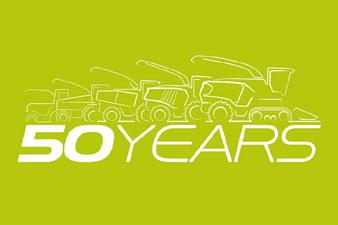
JAGUAR Timeline:
1970s
1973: Launch of the JAGUAR 60 SF.
1975: The 213hp JAGUAR 80 SF is added
1977: The JAGUAR 70 SF replaces the JAGUAR 60 SF.
1983: The all-new JAGUAR 600 generation introduced
1989: JAGUAR 600 S/SL/MEGA with a new cab, up to 354 hp is launched
1994: The transverse engine layout introduced on the JAGUAR 800.
1980s 1990s 2000s
The 10,000th JAGUAR is built
2001: The JAGUAR 900 takes power levels up to 605 hp.
2003: JAGUAR SPEEDSTAR approved for 40 km/h road travel.
2004: Production of the 20,000th JAGUAR.
2006: Launch of the JAGUAR 900 GREEN EYE
2008: Launch of the all-new JAGUAR 900 model series with DYNAMIC POWER
2009: The 25,000th JAGUAR produced
2011: CLAAS builds the 30,000 JAGUAR with a special black paint finish.
2014: Update to the JAGUAR 800 series
2017: The new-generation JAGUAR 900 with a continuously variable front attachment drive
2019: JAGUAR 900 TERRA TRAC introduced CEMOS AUTO PERFORMANCE launched
2019: The 40,000th JAGUAR forage harvester leaves the production plant
2010s 2020s
2022: GPS PILOT CEMIS 1200 introduced
2023: The fiftieth year of the CLAAS JAGUAR
HarvesTimes 19
The six-cylinder vs the V8

Based on the footsteps of the Giant’s Causeway, McConaghy Contracts operates a pair of CLAAS JAGUAR 970s that clear nearly 5,000 hectares of grass silage and wholecrop. Just like the JAGUAR forager range, the family business has grown and evolved to what it is today.
“Myself and my twin brother Silas, convinced our father to buy our first tractor in 1949,” recalls Robert ‘Bob’ McConaghy. “Back then you had to prove to the Department of Agriculture that you needed a tractor, and if your land was spread out enough you could have it on rubber rather than steel wheels. Then of course we needed the implements to go behind it which included a square baler which we bought in 1956. At the time bales were a standard length, but we fitted a modification that allowed us to make half length bales. We were able to bale green grass and make our first silage bales for us and our neighbours.”
The successful family contracting business has continued to grow, moving from bales to a series of trailed single-, double-and precision chop machines and their first self-propelled in 1978. But in 1989 the McConaghys went to a demonstration of the CLAAS JAGUAR 690 and were impressed by its appetite for big rows of grass.
“My mother asked what did we think, and I told her how it was able to pick up twice as much grass as our current machine,” says Robert Junior. “She commented if that was the case it must be a wild pile of money, but my father came in and said he didn’t care how much it was, we were going to buy one.”
And with that, the demonstration machine was promptly purchased from nearby dealer McElderrys who held the CLAAS franchise.


“Our next 690 had big improvements, the driveshafts had less angles and it had the newer cab,” explains Bob. “A MEGA 695 arrived in 1992 with the 24 knife system, it didn’t really have enough horsepower and it was inclined to heat if pushed. Trevor Campbell who now works for CLAAS brought out a demo 840 and we went side by side with our 695, but it wasn’t any quicker, that is why we went for the JAGUAR 860, we wanted more horsepower.”
20 McConaghy Contracts, Bushmills, County Antrim, Northern Ireland

My father came in and said he didn’t care how much it was, we were going to buy one.
Robert McConaghy
That first JAGUAR 860 made a massive impression on the McConaghys and stands out as one of the milestone machines that allowed them to clear more acres per day, “It was a completely different animal,” notes Robert. Likewise the first 40km/hr transmission in the JAGUAR 900 SPEEDSTAR meant it could keep pace with the tractors and arrive together at the next job, reducing waiting times and upping daily outputs.
There was only one obvious choice when it came to adding a second forager to the business to run alongside their JAGUAR 960, another CLAAS machine, a JAGUAR 890. For over five years now two foragers have tackled the sizeable area with often catchy seasons. They need reliability and the JAGUAR have proved to be just that, as has the service from local dealer ERWIN.
Today two JAGUAR 970s are tasked with getting the job done, but which is better, the V8 or the newer straight six?
“The six-cylinder, without a doubt. Earlier this year AR Imagery did a video of both machines working side-by-side,” says Robert.
“There was a camera in the cab of both machines, and you can hear Andrew Browne in the V8, tell Snowy (David McAllister) to slow down as he just couldn’t keep up. The six-cylinder has a good edge on the V8.”
The three generations of McConaghys now involved in the business, Bob, Robert and Andrew, agree that the latest pickup is superior to the previous version, the bigger auger taking in any lumps without a flutter and it also floats over the land.
While they have previously harvested maize, wholecrop has proved to be a more reliable crop on the north coast of Antrim.
The combine style header used on the early 600 series couldn’t meet the appetite of the first generation JAGUAR 800s and the business moved to the DIRECT DISC 600 when it came to the market, but both Bob and Robert nod in agreement that the newest generation header is even better again, and is used to directly cut an increasing area of rye as well as wholecrop for the mainly dairy farmer customers.
HarvesTimes 21 JAGUAR 970
Three generations of McConaghys are now involved in the business, Bob, Andrew and Robert.
Section Control for LINER swathers

All BUSINESS versions of the CLAAS LINER 4700, 4800 and 4900 four-rotor swather range are now available with Section Control for use with ISOBus TC-SC Task Controller to enable automatic lifting and lowering at the headland, so greatly reducing the operator’s workload and simplifying the operation.
Working with large-scale rakes with individual rotor lift at the headland or tapered field edges often requires a great deal of concentration on the part of the operator. To make their job easier, from the 2024 season all LINER 4700/4800/4900 BUSINESS models can be ordered with Section Control, and a retrofit option is available for existing LINER BUSINESS machines.
When engaged, the rotors are automatically raised and then lowered again at the headland and tapered field edges, depending on the position of the tractor-rake combination, so avoiding the need to manually raise and lower all four rotors individually, which calls for a high degree of concentration and often a reduction in forward speed.
With a working width of 12.70 m, an average field length of 250 m and a work rate of 100 ha per day, this potentially involves more than 300 headland manoeuvres a day. By automating the process with Section Control, this reduces complexity when working with large-scale swathers and makes operation easier for less
experienced operators. On long working days, practised operators will find their workload noticeably reduced, while the risk of operator errors – especially during night shifts – falls considerably.
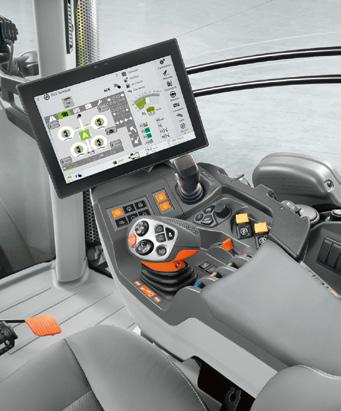
22
PRODUCT NEWS


HarvesTimes 23 swathers CLAAS
For all your farm workshop consumables Find out more about CLAAS FARM PARTS claas.co.uk
FARM PARTS
W J Hobbs & Sons,
Cliff-top quality forage
While holiday makers may flock to the cliffs of the north Cornwall coast for its beauty, farming there is not without its challenges, least of all the weather coming straight off the Atlantic ocean.
With a dairy herd of 300 cows, plus followers, and supplying milk to Saputo Dairy’s (Dairy Crest) Davidstow creamery for Cathedral City Cheddar, forage quality is important to brothers Mike and Stephen Hobbs and Stephen’s son-in-law David Pipe, to optimise milk from forage, but also maintain milk quality and the premium that attracts.
The partnership farm of 160ha is split between two units, one on the cliffs at Morwenstow which houses the followers with the dairy unit slightly further inland. They also rent a further 40ha of grass. To ensure they can work around the weather, they do
their own foraging, relying on a 2001 JAGUAR 820, that they bought in 2018 with 4,000 hours on it.
Supporting the JAGUAR is a set of DISCO 3200 front and rear mowers, a LINER 3100 rake and VOLTO 65 tedder all sourced through HAMBLYS, along with their ARION 630 and 620 tractors.
“We only make around 320ha of silage a year and we grow 28ha of maize, but because foraging days can be limited, having our own foraging equipment gives us flexibility and complete control over the operation,” explains Stephen.
“Prior to the JAGUAR we ran a trailed forager, but the JAGUAR has revolutionised the operation as well as freeing up a tractor. I love the simple, straightforward design with the chopper directly driven from the engine. It’s basic physics that makes the most of the power from the engine, which is bulletproof.
“Having the machinery flexible and adaptable is important, as conditions can vary considerably. We like to aim for moisture
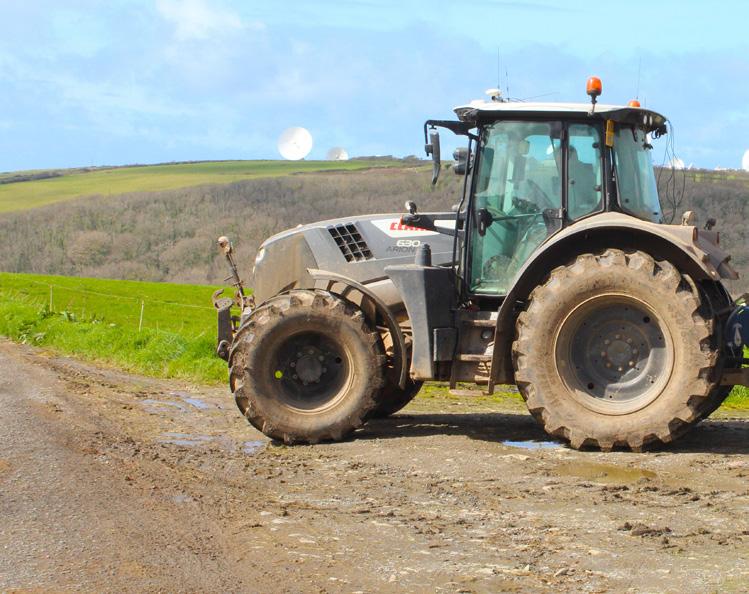
24
Dairy Farmers, Cornwall
contents in the high 20s to low 30s. Because of the wind, on the cliffs we will often mow and pick up on the same day, whereas inland we may need to leave it 24 hours to wilt.
We only ted as and when necessary or for baled silage for the followers, so the VOLTO is only really there for insurance – we are definitely not wearing it out.”
With yields of around 9,000 litres, with butterfat at 4.5% and proteins of 3.5%, concentrate usage is kept to a minimum. The herd is also split in two, with the higher yielding cows housed all year round, fed during the spring and summer with zero grazed grass harvested using the front-mounted DISCO 3100FC with a 25m3 forage wagon towed behind.
“The system works well. We start zero grazing as soon as possible in the Spring and it has certainly helped preserve our grazing, avoid damage from poaching and overall has certainly improved the sward and so maximise grass quality.”

The important thing for us is reliability. Running new, modern machinery definitely makes life easier and CLAAS equipment is designed for hard work. You can go out and do the job confident that you will not have any problems.
Stephen Hobbs

Hobbs
HarvesTimes 25 DISCO, LINER, VOLTO
Stephen
SCORPION on track at Le Mans
This year’s Le Mans 24 Hours race will see SCORPION telehandlers being used as recovery vehicles for car and truck races at the racetrack. This follows the signing of an Official Supplier agreement between CLAAS and the Automobile Club de l’Ouest, the organizer of the popular ‘24 Hours of Le Mans’, that includes the provision of CLAAS SCORPION telehandlers for each of the races organized by the ACO for the coming three years.
The main ‘24 Hours of Le Mans’ race enjoys a worldwide audience of over 146 million viewers through TV and streaming providers.
“CLAAS is very proud to have been chosen as a supplier by the organizer of the world’s greatest endurance race for the benefit of track and driver safety”, says Dr. Martin von HoyningenHuene, CTO CLAAS Group.
“Being extremely manoeuvrable as well as powerful with its high-performance hydrostatic transmission, our SCORPION telehandlers will be an excellent solution to support vehicle recovery and keep the racetrack safe.”
The link between the ‘24 Hours of Le Mans’ circuit and CLAAS Tractor has long existed, through events and visits by thousands of visitors of all nationalities to the CLAAS tractor assembly plant, thus contributing to the international reputation of both ACO and CLAAS. “But there are even more links between us”, resumes von Hoyningen-Huene. “The competitive nature and sportsmanship of racing fit to our own engineering values and help accelerate technical progress and R&D in many ways.”
REDUCING CARBON FOOTPRINT WITH SUSTAINABLE HVO FUEL
A range of different SCORPION telehandlers will be provided to support all races held in 2024, with a peak of 22 machines for the legendary ‘24 Hours of Le Mans’ (12 – 16 June 2024; main race on June 15/16). The SCORPION machines made available will run on HVO (hydrotreated vegetable oil) fuel to limit the race’s carbon impact.
This solution enables the machines to reduce CO2 emissions by up to 90 percent using HVO100, yet always offering maximum flexibility by enabling HVO and fossil fuel to be mixed in all required rations or for only diesel to be used when no HVO is available. Energy density and fuel consumption of HVO are competitive to fossil fuel. Another advantage of HVO, which consists of residues from vegetable oils and - depending on the supplier - sometimes animal fats as well, is the immediate effect to the environment.
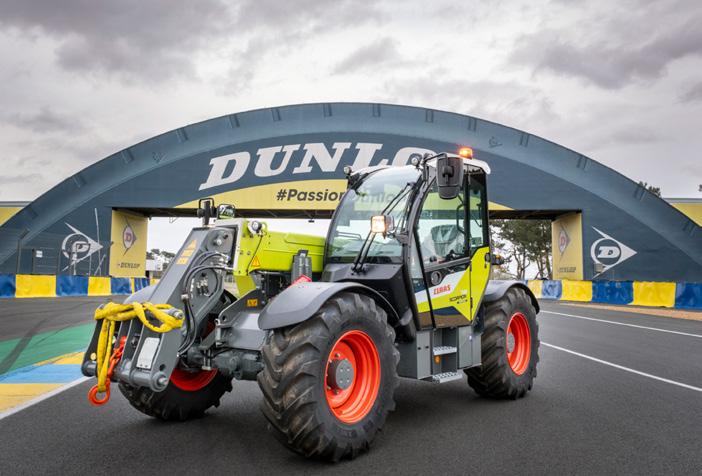
26
PRODUCT NEWS

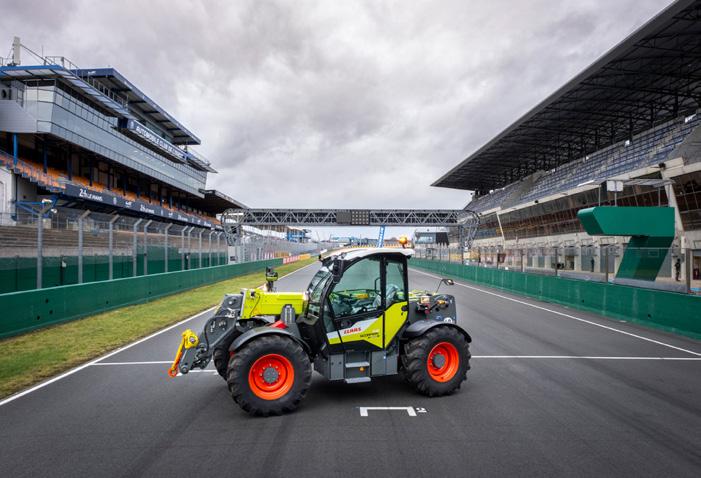
HarvesTimes 27 PRODUCT NEWS
New FL C front loaders for AXOS and ARION

of the parallelogram downwards by more than 20 cm. This gives the operator an even better view of the frame and attachment, especially as the front crossbeam has been lowered by 10 cm.
The new design features the customary robustness and manufacturing quality that is a hallmark of CLAAS front loaders. The boom is also designed for the most demanding tasks. All hydraulic hoses are integrated into the frame for protection.
The automatic bucket return function automatically returns the bucket to the horizontal loading position – increasing operator comfort and productivity to boot.
Optional LED work lights illuminate the loading area perfectly in the dark. The new design and features transform the AXOS and ARION into even more productive loading machines.


HarvesTimes
AXION TERRA TRAC – as a key

Use of the AXION TERRA TRAC with three-point mounted and trailed fertilizer spreaders and crop protection sprayers: More and more farmers and contractors are utilizing the conceptual advantages of the CLAAS large tractor in spring as well, making it a year-round all-rounder.
Exceptionally high levels of precipitation and high temperatures over the past winter have led to poor accessibility of fields and meadows in many regions of Europe. Under these difficult conditions, the AXION TERRA TRAC from CLAAS has repeatedly proved its versatility for spring fertilization and plant protection application work.
In large parts of Europe, the past winter was significantly too wet and too warm. Thanks to the high levels of precipitation, the soil layers that dried out in the drought years 2021 to 2023 are now filled with sufficient plant-available water again. However, the soils of lower-lying and boggy fields in particular, as well as undrained fields, still have limited bearing capacity and trafficability. Even on areas with clay layers in deeper soil levels, rainwater is currently only seeping away slowly.
Under these difficult conditions, the AXION TERRA TRAC from CLAAS has become a key machine on many farms and for contractors. “In recent years, some customers have already been using their AXION TERRA TRAC for mineral or organic fertilization in February and March, especially in regions with a lot of rain and only short periods of ground frost,” says Oliver Beekes, Head of Tractor Sales, CLAAS UK. “Many areas are almost impossible to drive on with wheeled machines in the first few weeks after the end of the lockdown period without leaving deep tracks. At the same time, there is a high risk that the vehicles will get stuck and have to be recovered at great
expense in terms of machinery and manpower. This applies to tractors with mounted fertilizer spreaders and correspondingly high rear axle loads as well as tractors with trailed crop protection sprayers for liquid fertilization as well as application drums, distribution booms and hose reels or manure spreaders for organic fertilization.”
Thanks to its long TERRA TRAC crawler tracks on the rear axle, the AXION TERRA TRAC can also support heavy loads without damaging the soil and also tracks stably and almost slip-free on wet surfaces. With 735 mm wide tracks, it offers 35 percent more contact area than a comparable tractor with 900 mm wide rear wheels, which roughly halves the ground pressure in the topsoil and underbody. Thanks to the sprung running gear, optimum ground tracking is also ensured at all times, which reduces the risk of pressure peaks at certain points. In addition, the active steering intervention in the undercarriage drive enables the AXION TERRA TRAC to move from the tramline to the headland and into the next tramline without damaging the soil. “Our customers report that with the AXION TERRA TRAC they can drive into their fields two to three weeks earlier than with wheeled tractors,” Oliver continues. “What’s more, even trailed spreader wheels sink in less, as the top layer of soil is not excessively compacted by the AXION TERRA TRAC and the soil structure is largely retained. In other words, the AXION TERRA TRAC leaves behind stable soil instead of mud.”
CLAAS presented the AXION TERRA TRAC as a prototype at Agritechnica in 2017 and launched it for sale in 2020. The large tractors are now marketed not only in European countries, but also in North America and Australia. Thanks to its unique TERRA TRAC crawler tracks, it is still the only full-suspension
30 PRODUCT NEWS

machine for spring fertilization
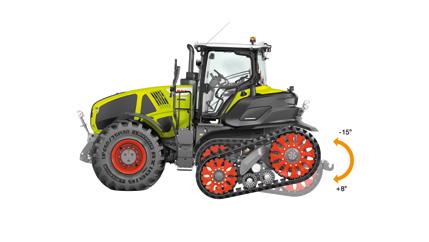


Minimal track formation even with high soil moisture: The soil structure in the track remains largely intact, so that trailed implements or subsequent operations benefit from improved load-bearing capacity and sink in less.
tractor in this machine segment. The ground adaptation resulting from the special design of the undercarriages not only increases comfort, but also ensures more even pressure distribution and uncompromising tractive power, even on uneven fields. “The AXION TERRA TRAC was primarily developed for heavy traction work,” summarizes Oliver Beekes. “But since its market launch, it has increasingly proven its suitability as a year-round all-rounder, from fertilization to grass or green rye mowing and silage use to the heaviest traction work in soil loosening, tillage and sowing.”
The advantages of the AXION TERRA TRAC in spring fertilisation summarised:
• 35 percent more contact area with 735 mm tracks compared to 900 mm rear wheels (both with 710 mm front wheels; total contact area on the AXION TERRA TRAC approx. 4 m2).
• With 900 mm tracks, the contact area increases by a further 20 percent compared to the 735 mm tracks.
• Ground pressure in the topsoil is only 0.5 bar, in the subsoil 0.45 (40 cm depth) to 0.2 bar (60 cm depth). A comparable wheeled tractor has 1.0 bar in the topsoil and 0.75 to 0.4 bar in the subsoil (40 and 60 cm depth).
• Extremely low track formation at high soil moisture levels - regardless of the soil type.
• No “bogging down” of the AXION TERRA TRAC plus implement combination: No need for time-consuming recovery operations, as is currently increasingly the case with wheeled tractors.
• High tractive power and traction reserves in conjunction with semi-mounted fertilizer spreaders and crop protection sprayers.
• Virtually slip-free traction of fertilizer spreaders and crop protection sprayers: No smear layers due to soil shearing in the tracks.
• The soil structure in the tracks remains virtually intact - as a result, attached fertilizer spreaders and crop protection sprayers sink in less.
• The passability for subsequent operations is significantly better if the first pass on the tramlines in spring is carried out with the AXION TERRA TRAC in a way that protects the soil.
• Significantly easier harvesting due to minimal track formation.
HarvesTimes 31 PRODUCT NEWS
Rory Young

Festive harvester
Having up to 50,000 Christmas trees to harvest in a very intensive three-week period calls for reliable machinery and prompt, efficient service should there be any problems.
Based just south of Dumfries, at any one time Glaisters Farms have over 600,000 Christmas trees in the ground that are sold under the Scottish Christmas Trees brand, mainly to wholesalers throughout the UK, but also into Europe.
“We mainly grow Nordmann, but also have Fraser Fir, and the largest trees we supply are 15ft,” explains Rory Young. “The vast majority go to wholesalers but we do supply quite a few arable farmers in the eastern counties who are near large towns and cities and have diversified into selling trees on-farm.”
Harvesting starts in early November with trees for export, and then ramps up after November 10 through to early December with up to eight lorry loads of trees leaving the farm each day.
“It’s a stressful and very intensive few weeks,” states Rory. “All the trees are cut to order. Once cut, a tree is a perishable item and has a given life, so it is vital that we deliver that tree in optimum condition. Some customers do dictate when trees are to be cut and delivered and we pride ourselves that when we say we will deliver, we do deliver that day.”
Key to the harvesting operation are four harvesting rigs, one of which is mounted on an ARION 460 purchased a couple of years ago from GORDONS.
“The ARION is ideal for our needs. The tractors we previously ran were getting too advanced, which was reflected in the price. The ARION has a very good engine and straightforward transmission, so is far more cost effective for our needs. But the most important thing for me is the service and back-up that GORDONS provide. The tractor is also covered by a 5-year warranty and it is hard to look past that when comparing tractors.”
The trees are grown in 20m wide beds, separated by 4.0m wide tracks. Each of the harvesting tractors is fitted with a tablet running the farm’s own app.
32 Rory Young, Glaisters Farms, Christmas Tree growers, Dumfriesshire

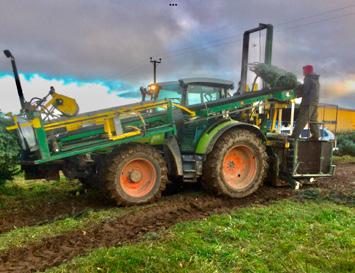

The most important thing for me is the service and back-up that GORDONS provide. The tractor is also covered by a 5-year warranty and it is hard to look past that when comparing tractors.
Rory Young
Each day, Rory allocates specific orders to each team, detailing height and number of trees required, which block the trees are to be harvested from, and ultimately in which of 10 bays each order is to be left ready for loading onto lorries.
After cutting using hydraulic secateurs, the trees are manually moved to the trackways down which the packing rig travels.
The trees are fed butt first into the rig, where they are initially net wrapped, before being carried up a conveyor to the rear of the rig for stacking into a box crate, that when full is compressed and bound. This is then offloaded for transport back to the farm and its allocated bay.
“The harvester is pivotal to the whole operation and ensuring we can meet our deadlines. Despite the high degree of mechanisation, it is physically demanding work.
Each tree is handled at least three times and we aim to harvest five lorry-loads a day, so the teams will manhandle around 52 tonnes of trees. Regardless of conditions we will keep harvesting until that day’s allocation is completed and if there is a breakdown, then that time will have to be made up.
“Over the course of the year, with other work around the farm and maintenance work such as mowing the tracks and powering a mistblower for spraying the trees, the ARION will only do around 800 hours.
“But 250 of those hours will be over those three weeks during which time, while the tractor may only be running at tickover, the hydraulic pump is constantly working, so does place a load on the tractor.”
HarvesTimes 33 ARION 460
A win for CLAAS tractors

The last two years have seen a change of tractor colour in the yard at SRUC’s Easter Howgate farm near Edinburgh, following the arrival of an ARION 410 in 2022, followed by an ARION 630 and AXION 810 last year.
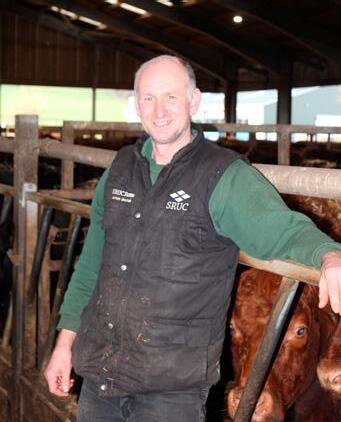 James Marshall
James Marshall
I like the ARION 410 because it’s a very good, straightforward tractor that’s extremely manoeuvrable and easy to get into tight buildings.
James Marshall
The decision to change to CLAAS tractors was made following an exacting procurement process, part of which took into account the opening of SELLARS’ new depot at Stirling, and the service and support this would provide for the institution and its tractors.
“As a public body we have to follow a very clear and open procurement process,” explains James Marshall, who manages the 1,000ha commercial and research farm, some of which is owned by SRUC, the rest being rented from the University of Edinburgh and the MOD. The farm also provides students from SRUC’s Oatridge and Edinburgh campuses with on-farm practical experience, such as driving tractors, fencing and handling livestock.
“We will get three quotes and in addition to price, we also look at aspects such as the service and support, the proximity of the dealership and how easy it is to get there if we need to collect parts.
“Had it not been for SELLARS opening their new branch at Stirling, we would not have looked at them as the distance to their other branches would have been a tick against them.
34 James Marshall, SRUC Easter Howgate, Midlothian
ARION 410
ARION 410, ARION 630 and AXION

“There is no favouritism in the process, and despite having initially bought the ARION 410, it was not a given that we would buy CLAAS again and it was very much the case that SELLARS had to win the contract.”
Ranging in height from 200 to 650 meters, in addition to arable on the lowest ground, the farm also grows 91ha of silage and 40ha of whole crop for its beef cattle and lowland and hill ground sheep flocks.
The small ARION 410 is mainly used with a straw chopper and general running around and haulage work. The ARION 630 spends most of its time powering the farm’s 18m3 feeder wagon, but when not doing that is also used for ploughing and cultivations while the AXION, which has GPS steering and TELEMATICS, is responsible for heavy cultivations, hedge cutting, muck and umbilical spreading.
“For the students its important that we run a modern fleet of tractors with the technology that they will probably find when they go on to work on farms,” says James.
“I like the ARION 410 because it’s a very good, straightforward tractor that’s extremely manoeuvrable and easy to get into tight buildings. On the other hand having the AXION with its CMATIC transmission and the CEBIS and CEMIS terminals gives us the ability to accurately apply inputs, but also for students to learn how to set-up an arable tractor and use technology such as GPS. Technology is there to be used so it’s important that we teach that.
“It’s also important that we not only run tractors and machinery that are safe to use, but that we also pass that onto the students. We have a lot of eyes on us so we use the Smart Farm app to ensure that everything is recorded properly and all the information that the operator needs is available to them.
“I have been very pleased with the tractors. The service from SELLARS is excellent and any problems have only been small issues that have been quickly dealt with. It helps that Steven (Malcolm) comes from a service background so in addition to being a good salesman who will give you a realistic price first time, he is very strong on the practical side and especially on electronics.”
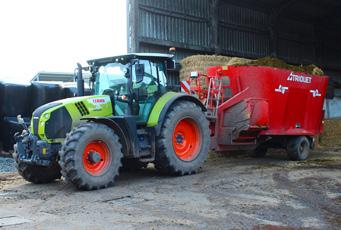
HarvesTimes 35
810
630
AXION
810 ARION
CEMIS simplicity
Mike Davey concedes that when it comes to GPS steering, he has come to the party rather late. But now that he’s there he can see the benefits it brings. Key to that has been how easy he has found the new CEMIS 1200 with GPS PILOT to use and the confidence it brings to delve deeper into the other functions available.
“It’s something I probably should have done about 10 years ago, and David (Penrose) at HAMBLYS had been on at me for a while that I should have GPS, but I am of an age where I was quite happy without it. But now that I have it, I realise what I have been missing.”
Based near Truro, Mike travels throughout Cornwall annually spreading about 12,000 tonnes of either lime, Fibrophos or sea sand dredged from Padstow harbour. “Sand is less expensive and slower acting than lime, and about two tonnes of sand equates to about 1.5 tonnes of lime,” he explains. “Vegetable growers on rented land will generally opt for lime as that will be faster acting, but it’s often used by cereal farmers. Some vegetable growers on their own land can be applying up to 12.5 tonnes of sand per hectare in order to raise Ph levels to 8 which helps to avoid club root.”
If I run out half way down a field, it makes it far easier to return to the exact place, especially after first cut silage where it can be difficult to see your mark.
Mike Davey
Mike has been running CLAAS tractors for over 20 years and the move to GPS steering came having changed his previous ARION 650 CIS+ for a new 650 CEBIS last August. “The old ARION was coming to the end of its 5,000 hour warranty. The new 650 was a stock tractor that had all the ‘bells and whistles’ on it and the deal was right. The only thing I had to add was a new FL120 loader for it.”
“Over the years I have spent all day staring at my last wheel mark and I like to think I am good at estimating 12 metres. But having GPS has certainly made life a good sight easier! It enables me to keep an eye on the spreader and even to take in the view with a cup of tea.”

36
Lime/Sand/Fibrophos spreading contractor, Cornwall
Mike Davey,

“But it’s also things like if I had a couple of spreader loads left to spread as it was getting dark, I would have to come back in the morning because I couldn’t see my last wheel mark. Now I can finish the job in the dark and get onto the next job first thing the next day. Also, if I run out halfway down a field, it makes it far easier to return to the exact place, especially after first cut silage where it can be difficult to see your mark. And because all my wheelings are exactly parallel, it looks more professional.”
Introduced in 2022 and developed in-house by CLAAS in conjunction with Trimble, CEMIS 1200 is the new standard terminal for handling online documentation, ISOBUS and TASK controller applications and GPS steering using the SAT 900 multi GNSS receiver and comes as standard with the SATCOR 15 correction signal giving +/- 15cm accuracy.
“The staff at HAMBLYS have been very good at taking me through the basic functions, but it’s extremely straightforward to use and that has given me the confidence to just fiddle and play with it and self-teach to see what else I can do with it, knowing I can easily escape and not mess up everything. Likewise, the new touchscreen CEBIS in the tractor is also very self-explanatory, so again making it easy to just see what else I can do with it.
“David’s persistence has finally paid off and that’s what I like about HAMBLYS. It’s a two-way relationship and all the team at Redruth are fantastic. If I have a problem, they will talk in terms of hours and minutes which makes all the difference.”

HarvesTimes 37
ARION 650 CEBIS
Mike Davey
Craig and Claire Grant, Farmers of the Year, Aberdeenshire
Award winners
Last October saw Craig and Claire Grant travel from Aberdeenshire to London, where they were not only awarded the Farmers Weekly ‘Mixed Farmer of the Year’ award, but then much to their surprise went on to be presented with the overall ‘Farmer of the Year’ award, both of which now sit alongside the ‘Young Farmer of the Year’ award he won in 2012.
The awards recognise the impressive expansion of Craig and Claire’s farming business, having started from scratch in 2008 when Craig returned home from working as an engineer in the oil industry, determined to set up his own farming business.
Today the business, which is based at Kindrought north of Aberdeen, encompasses 260ha of arable crops, a lot of which are grown for on-farm feed, and 160ha of grass on owned and rented land, along with a further 240ha that is contract farmed. In addition to 285 bulling heifers, they also accommodate a flying flock of 600 ewes and 1,000 lambs, plus they finish a further 1,800 lambs. Alongside this they also have 160,000 laying hens supplying eggs mainly to Lidl and Aldi, but also under their own brand to local Tesco stores and some contract work consisting mainly of sowing, spraying and spreading poultry manure.
The used CLAAS tractors have been key to our growth
Craig Grant

38
Craig and Claire Grant with their Farmers Weekly ‘Farmer of the Year’ and ‘Mixed Farmer of the Year’ plaques.
AXION 800, ARION 650/640/630

The Grant’s tractor fleet includes an AXION 800, two ARION 650, a 640 which is Craig’s ‘pride and joy’ and a 630.
Key to their success has been a willingness to accept any opportunity that comes their way, together with a meticulous eye on costs not least when it comes to machinery. In this respect Craig credits local CLAAS tractor dealer BRUCE FARM MACHINERY and Foster Bruce as having been integral to the growth of the business.
“CLAAS tractors and Foster have been very important parts of my life. I have known him all my working life, so when I came home in 2008, starting up myself and requiring a tractor, I approached him about what he could find for me on a very tight budget.
“He came up with a ‘02 plate Renault 696 with 5,000 hours on it that cost £17,500 and for four years that tractor was carrying out various jobs, but mainly planting hedges and trees all over Scotland. In 2013 it was time for an upgrade and Foster found me a ‘10 plate ARION 640 with 3,800 hours, which has now done over 12,000 hours and,” says Craig, “is my pride and joy and the one tractor I will never sell.”
Since then, as the business has kept growing, Craig has gone back to Foster for more tractors. Next came a ‘54 plate 696 Renault with a loader and 7,000 hours that was then traded in for a ‘12 plate ARION 630 with a loader and 2,500 hours that now sits at 8,500 hours. 2022 saw the arrival of another ‘13 plate ARION 640, which only stayed a year before being replaced in 2023 by a new 650 ARION CIS+.
The fleet also currently includes a 2020 plate ARION 650 bought in July 2023 which is also fitted with loader brackets, plus a ‘17 plate AXION 800 sourced from SELLARS, only because having taken on more arable land, he required a higher powered tractor and it was immediately available.
All the tractors have been bought outright, the only exception being the ARION 650 that arrived in April last year and is the only tractor to have been bought new.
“Due to increased workload a tractor upgrade was necessary. It was a stock tractor available immediately from Foster’s yard with the offer of 5-years 0% finance on it, so everything came right and the whole deal from seeing it to signing was done in an hour!
“I’m not into bartering deals backwards and forwards. I don’t have time and I trust Foster’s advice when it comes to used tractors. It’s all about balancing reliability against price.
“As the business has rapidly expanded in different directions, we have had to keep a tight control on expenditure and by buying machinery outright, that has released capital that can be used to purchase additional machinery, that would otherwise be tied up to fund interest.
“The used CLAAS tractors have been key to our growth. If we had bought new, because of the higher cost and interest we would never have been able to maintain growth and we now have a fleet of five tractors that work hard and ideally meet our needs. Nothing’s an ornament; with our tight weather windows they give us the ability and machinery to be able to get the job done.”

HarvesTimes 39
Craig Grant (right) and brother Mark, with tractor driver Ryan Irvine.

Treading lightly...
Paul Lakey is the first to admit that when son Alan suggested fitting a CTIC variable tyre pressure system to their new AXION 870 CMATIC, he was sceptical. Six rather wet months later he freely admits that it has been the making of the tractor.
“Customers have also been sceptical about the need for such a system, but that soon changes when they see what a difference it makes,” says Paul. “On one heavy land field, the customer said the only way we would be able to plough it using a 7-furrow was with a crawler, but once we had dropped the tyre pressure the AXION was pulling it easily.
“I may have initially thought it was not worth the money, but the proof is in the pudding and until you see the difference it makes,
you would not believe it. For reducing compaction, increasing traction and overall performance it really does make a big difference.”
Based at Gedney Drove End close to the Wash, P A Lakey & Son farm and contract farm around 800 ha in addition to offering a wide range of arable and sugar beet contract services throughout the Fens.
One aspect of the business that has seen a considerable rise in demand is for autumn and spring drilling of both arable crops and vining peas. As the main drilling tractor, the 280hp AXION 870 which has a boost to 295hp, is used with either a 6.0m Vaderstad or a 4.0m Sulky combination drill, depending on conditions.
“While the AXION, and the 870 it replaced, are fine with the Vaderstad, because of the weight of the combination drill and front press being carried on the tractor, wheelings were a problem,” explains Paul.
40
Son, Farmers
contractors,
P A Lakey &
and
Lincolnshire
Paul (right) and Alan Lakey
When reduced to 0.6 bar, in addition to a longer footprint to reduce compaction having three cleats in contact with the soil instead of two helps increase traction.

One option he and Alan looked at was to fit wider tyres in place of the 650 and 710 Michelin Ultraflex tyres fitted on the front and rear of the AXION, potentially going up to 800s. However, they ruled this out due to the issues with width, especially when ploughing, resulting in Alan suggesting that they go down the variable tyre pressure route instead, with the CTIC system being fitted by their local CLAAS dealer A WOODS.
For drilling, at the press of a button Alan drops the pressure he has saved in CEBIS from 1.6 bar for roadwork to just 0.6 bar on the front and 0.8 for the rear which, he says, provides a happy medium and gives the equivalent footprint of an 800 tyre.
“In addition to reducing compaction pressure, the longer footprint also has the benefit that there are three cleats engaging with the soil instead of just two, so traction is also increased and this must also be helping reduce fuel consumption.
“Certainly for jobs like ploughing and sub-soiling you can see the difference reducing the tyre pressure makes, and even in this year’s very wet conditions I have not left a mark when combination drilling.
“Generally I will just tweak the settings while doing the first breed down the field so as to find just the right pressure.
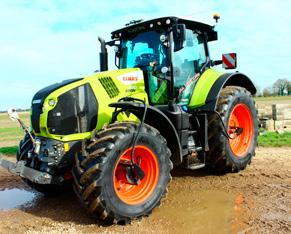
GRANT ELIGIBLE
A grant of 60% is available in the UK for purchasing the CLAAS CTIC variable tyre inflation system in the latest Farming Equipment and Technology Fund scheme, reference FETF109.
For more information please search for FETF 2024 at www.gov.uk
“Then when finishing, when I am about halfway up the field on the final pass, I press the button to inflate the tyres again, so that they are at road pressure by the time I reach the gate.
“The AXION 870 is a fantastic tractor. It’s the ideal size for what we need, and has enough power to pull the Vaderstad drill but is not too big and cumbersome. It’s a very well balanced tractor and the CMATIC transmission puts the power down well to the wheels but having the CTIC variable tyre pressure system ensures that we can really make the most of that engine power and torque.”
The AXION 870 is a fantastic tractor. It’s the ideal size for what we need, and has enough power to pull the Vaderstad drill.
Paul Lakey
HarvesTimes 41 AXION 870 CMATIC
Efficiently powering the world’s
 Rupert Arneil
Rupert Arneil
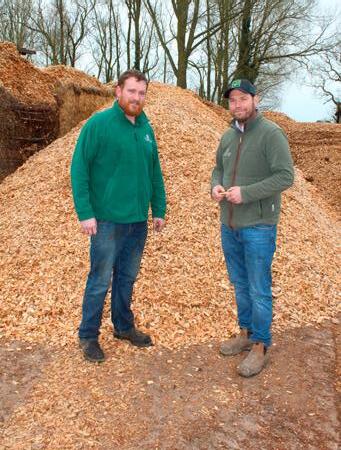
Powering a woodchipper capable of taking in hardwood timber up to 132cm in diameter takes some doing, but as the Cotswold Group has found it’s a job well suited to the XERION 5000.
In addition to general tree surgery and forestry work, a major part of the Cotswold Group’s business is chipping some 15,000 tonnes of timber and 15,000 of whole tree chip for use in biomass boilers on chicken farms.
Looking to increase his chipping capacity 18 months ago, Rupert Arneil opted to ‘go big’, investing in a Mus-Max W12 which, with a feed opening measuring 90x135cm, is the largest tractor powered woodchipper in the world.
With a power requirement of up to 600hp, this limited his choice of tractor to just two, of which he chose the XERION 5000 VC on account of the operating position provided by its reversible cab.
“The Mus-Max is a beast of a machine and it needs all of the 530 horsepower from the XERION,” states Rupert. “It will fill a lorry in 20 minutes, compared to nearly 50 minutes with our old chipper. In just 18 months the XERION, which we bought ex-demo from CLAAS WESTERN at 300 hours, has already clocked up 3,600 hours.”
Behind the controls for most of those hours has been operator Ian Smith, who agrees that one of the best features about the XERION is the reversible cab, but also its power and especially the torque.
“When its reversed, the visibility from the cab over the feed table and the chipper as a whole is brilliant. The fact that you have the foot pedals and all your controls readily to hand makes it so relaxing to operate and when you are sat there chipping it is really comfortable.
“But the torque (2,600Nm) is also unreal. When you load a big log it will pull the engine down, but it then just holds on and keeps pulling. Considering that the XERION is powering everything and I have the PTO speed set to exactly 1000rpm with the engine running at about 1,700rpm, the fuel consumption is extremely good and the AdBlue is fantastic – one fill will last me a week and at least three or four tanks of fuel.
“I have it set up so that the feed into the chipper will vary according to the engine revs, so as to keep the speed as constant as possible. Output, depending on the grade of chip, is between 50 to 70 tonnes an hour but the XERION engine is working constantly at a high load. The job is brutal because unlike an agricultural machine where the load is fairly constant, with the chipper the power load is always surging, which has to be hard on the engine. Despite that the reliability has been extremely good and whenever we have needed them, the support from CLAAS WESTERN has been excellent.”
42 Rupert Arneil, The Cotswold Group Ltd, Gloucestershire
Ian Smith and Rupert Arneil
world’s largest woodchipper


When its reversed, the visibility from the cab over the feed table and the chipper as a whole is brilliant.
Rupert Arneil
HarvesTimes 43 XERION 5000 VC
CLAAS tractors with TERRA TRAC crawler tracks
15% more traction, 50% less soil pressure
More comfort for the operator
More crop for the harvest

The AXION 900 TT:
• Two models – 445hp AXION 960 and 355hp AXION 930.
• Oscillating track system for maximum ground contact.
• The only truly suspended track system available today, coupled with PROACTIV front suspension and 4 point cab suspension.

Contact
your local CLAAS dealer today or go to offer.claas.com Soil-friendly cultivation.











































































 James Marshall
James Marshall











 Rupert Arneil
Rupert Arneil




